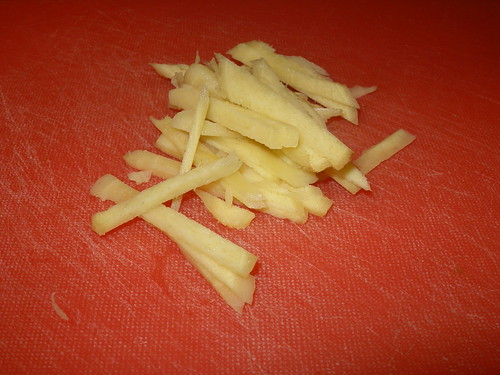
Miso. Butter. Uh…those are the ingredients for…miso butter. This is why David Chang is an evil genius. Way back when he was just a non-famous kid*, learning all about ramen in Japan, he happened upon the Sapporo stylings of miso ramen: finished off with a “knob” of butter and some corn. David notices the flavor combo is crazy good. He and his friends abbreviate the flavor insanity to miso + butter. Well, I have both butter and miso in the fridge, so why not? Doesn’t cost me anything.
What does miso butter taste like? It tastes so good it’s just WRONG!!! The umami in the butter melds with that of the miso to create this uber-umami whirlwind of deliciousness.
He has a fancy recipe for poached eggs with miso butter on asparagus, in his Momofuku book – I decided to try something more basic, elemental: why not just go for the miso butter as the major taste?
Miso Butter Asparagus Tart
Ingredients: (these are very very approximate measurements, due to this being an experiment)
- 1 yellow onion;
- two or three handfuls of asparagus pieces**;
- 1 sheet of puff pastry;
- 1 tablespoon of dark miso; and
- 2 tablespoons of butter.





Slice a whole yellow onion and saute until translucent. Allow to cool completely. Wash and slice the asparagus spears. If they are thicker than 1/3″, you may want to halve them.
Take the puff pastry out of the freezer and allow to thaw for the required time. Cut the puff pastry into modest rectangles (like 3″x2″) – I was using Pepperidge Farms puff pastry, which yields about 12 pieces. Transfer the pieces to a cookie sheet.
Melt the butter in the microwave – try it like 15 seconds at a time – and mix in the miso. Mix. Mix. Mix. Baste the miso butter onto the puff pastry with a brush. Put a thin layer of carmelized onion onto the pastry. Then top with the asparagus pieces. Baste the asparagus with yet more miso butter.
Set your oven to 425 Fahrenheit. (I fiddled with the temperature, all the way down to 350 at one point). Bake. Remove once the puff pastry has puffed (about 15 ~ 20 minutes, depending on how heavy the asparagus and onions are).
Remove, and wait for praise and adoration!!!
Notes – I cooked this in an oven with a see-thru door to help keep a vigilant eye over the tarts so that they did not burn too much. The miso burns mercilessly fast.
Taster Feedback:
One taster (who weighs no greater than 110 lbs, I believe) ate portions intended for three adults in one sitting! One taster complained that the tart should be more attractive, perhaps with carrot or something pretty. One taster liked the flakiness of the pastry and the nice taste of the asparagus and how it was all bound together with the miso. All tasters eagerly ate MULTIPLE servings!
* His dad ran golf businesses and David played competitive golf as a kid…I guess he had to get out because he could read the writing on the wall when Tiger Woods‘ face would be on the brochures…for the tournaments he was competing in!
** The asparagus in the picture consists only of the tips because I had used the stems for another dish. I was lucky enough to find it on sale for under $2.00 per pound during a weekly special. You could probably swap in summer squash or even scallions for a more frugal take.
P.S. Here’s a link to the Kitchen Window story from yesterday that has some background info on miso (and hastened my decision to post about my miso butter experiment)!


















